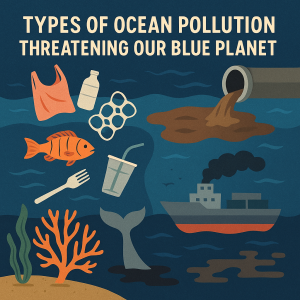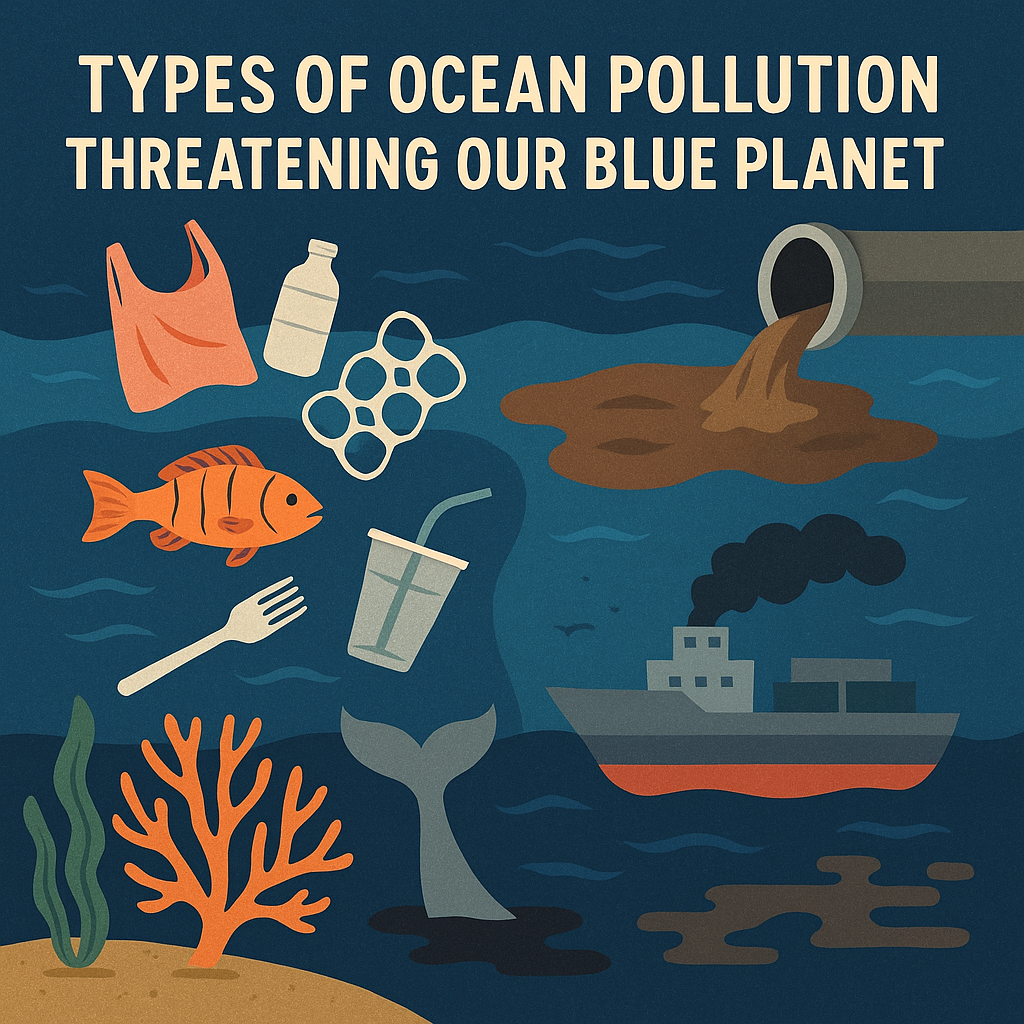Discover the top 12 types of ocean pollution threatening marine ecosystems and global maritime operations. Learn what causes them, their consequences, and how international regulations and innovation are tackling the crisis.
Why Ocean Pollution Matters in Modern Maritime Operations
 The ocean covers more than 70% of our planet’s surface, yet much of it has become a dumping ground for human activity. From plastics and oil to noise and heavy metals, the pollutants we introduce to the marine environment have ripple effects that impact fisheries, shipping, global trade, and climate regulation.
The ocean covers more than 70% of our planet’s surface, yet much of it has become a dumping ground for human activity. From plastics and oil to noise and heavy metals, the pollutants we introduce to the marine environment have ripple effects that impact fisheries, shipping, global trade, and climate regulation.
For the maritime industry, ocean pollution is not just an environmental concern—it’s a growing operational and regulatory challenge. Polluted waters increase biofouling, damage marine engines, affect port water quality, and trigger sanctions under international conventions such as MARPOL. But even beyond economics and law, we must confront a more profound truth: polluted oceans threaten food security, marine biodiversity, and the very balance of Earth’s climate system.
This article explores the top 12 types of ocean pollution, combining scientific evidence, maritime case studies, and regulatory frameworks to help you navigate one of the most urgent marine issues of our time.
Plastic Pollution
Plastic pollution is arguably the most visible and talked-about form of marine pollution today. More than 11 million metric tonnes of plastic enter the ocean every year, and that number is projected to triple by 2040, according to the Pew Charitable Trusts.
Sources:
- Single-use plastics (bags, bottles, packaging)
- Fishing gear (nets, lines)
- Microplastics from cosmetics, clothing fibers, and degraded materials
Impacts:
- Marine animals suffer from ingestion and entanglement
- Plastics break down into micro- and nanoplastics, entering food chains
- Navigation hazards from floating debris
Regulatory Response: The International Maritime Organization (IMO) has banned plastic dumping at sea under MARPOL Annex V. The EU’s Directive 2019/904 targets single-use plastics at ports and coastal facilities.
Oil Pollution
Oil spills may be less frequent today than decades ago, but they remain devastating when they occur. From large-scale tanker accidents to chronic oil leaks from pipelines and bilge discharge, oil pollution severely harms marine life and coastal economies.
Sources:
- Tanker groundings or collisions
- Illegal bilge water discharge
- Offshore drilling accidents (e.g., Deepwater Horizon)
Impacts:
- Smothers marine species and damages feathers and gills
- Long-term contamination of sediments
- Disrupts port operations and tourism
Regulatory Response: The CLC 1969 and MARPOL Annex I mandate strict controls and compensation for oil pollution damage. Many ships now use oily water separators and are monitored by AIS and satellite tracking via EMSA’s CleanSeaNet.
Sewage and Wastewater Pollution
Human waste, when untreated, introduces harmful pathogens, nitrogen, phosphorus, and pharmaceuticals into the marine environment.
Sources:
- Cruise ships and passenger vessels
- Coastal cities with poor sanitation
- Offshore platforms
Impacts:
- Algal blooms (eutrophication)
- Dead zones (oxygen-depleted regions)
- Human health risks from contaminated seafood
Regulatory Response: MARPOL Annex IV prohibits untreated sewage discharge in most marine zones. The Baltic Sea, designated as a “special area,” enforces particularly strict rules under the Helsinki Convention.
Chemical Pollution
Toxic chemicals such as pesticides, flame retardants, pharmaceuticals, and industrial waste persist in marine ecosystems, bioaccumulate in marine species, and affect reproductive and neurological systems.
Sources:
- Agricultural runoff
- Pharmaceutical residues
- Industrial discharge from port areas
Impacts:
- Coral bleaching
- Bioaccumulation in fish and seabirds
- Long-term genetic impacts on marine life
Regulatory Response: UN Environment Programme initiatives such as the Global Programme of Action for the Protection of the Marine Environment from Land-based Activities (GPA) are supported by IMO’s GloLitter and GESAMP (Joint Group of Experts on Scientific Aspects of Marine Environmental Protection).
Heavy Metal Pollution
Heavy metals like mercury, lead, cadmium, and arsenic originate from industrial processes and find their way into the food chain.
Sources:
- Mining runoff
- Ship hull corrosion
- Fossil fuel combustion
Impacts:
- Neurological damage to fish and humans
- Genetic mutations in marine organisms
- Shellfish toxicity
Regulatory Response: The Minamata Convention on Mercury, supported by the UN and IMO, works globally to reduce mercury emissions, including from marine sources.
Nutrient Pollution (Eutrophication)
While nutrients like nitrogen and phosphorus are essential to life, too much can create an overgrowth of algae, leading to hypoxic (low oxygen) conditions.
Sources:
- Fertilizer runoff from agriculture
- Sewage outflows
- Aquaculture effluents
Impacts:
- Oxygen depletion and dead zones
- Fish kills
- Coastal ecosystem collapse
Real-World Example: The Gulf of Mexico “dead zone” spans over 6,000 square miles each summer, largely due to fertilizer runoff from the Mississippi River Basin.
Marine Debris (Non-Plastic)
While plastic gets most of the attention, other debris types—like glass, metals, and ceramics—persist for decades.
Sources:
- Abandoned fishing gear
- Construction waste
- Lost containers from cargo vessels
Impacts:
- Navigational hazards
- Coral reef damage
- Entanglement of marine mammals
Regulatory Response: The London Convention and Protocol prohibit dumping harmful substances at sea. Flag states monitor cargo loss via the IMO’s GISIS module.
Ballast Water Pollution
Ballast water stabilizes ships but can also transfer invasive species, pathogens, and sediments across ecosystems.
Sources:
- Discharge of untreated ballast water in foreign ports
Impacts:
- Invasive species displace native marine life
- Algae or viruses can disrupt entire food webs
Regulatory Response: The Ballast Water Management Convention (BWMC) requires ships to treat ballast water using filtration, UV, or chemical systems before discharge. As of 2023, over 95% of global shipping tonnage is covered.
Thermal Pollution
When industries or vessels discharge warm water into the sea, it alters local ecosystems.
Sources:
- Power plants
- Desalination plants
- Engine cooling systems on ships
Impacts:
- Alters breeding cycles of fish
- Promotes harmful algal blooms
- Reduces dissolved oxygen levels
Scientific Insight: Research in the Marine Pollution Bulletin indicates that coral reefs near thermal outfalls are 20–40% more likely to experience bleaching.
Noise Pollution
Underwater noise may be invisible, but it’s extremely disruptive. Noise pollution interferes with whale migration, fish spawning, and even sonar use by navies.
Sources:
- Ship engines and propellers
- Seismic surveys
- Naval sonar
Impacts:
- Disorientation of marine mammals
- Increased stress levels in fish
- Disrupted communication and mating
Regulatory Response: The IMO’s 2014 Guidelines for the Reduction of Underwater Noise urge quieting technologies such as optimized propeller design and vibration isolation.
Light Pollution
Excessive artificial light near coastlines can confuse nocturnal and migratory species.
Sources:
- Coastal cities and ports
- Offshore oil rigs
- Cruise ships and fishing vessels
Impacts:
- Turtle hatchlings move inland instead of to sea
- Disrupted feeding and spawning patterns
Real-World Concern: Studies near the Great Barrier Reef show increased light disrupts the reproduction of reef fish and corals.
Radioactive Pollution
While rare, radioactive substances from marine accidents or waste disposal can remain hazardous for centuries.
Sources:
- Nuclear submarine accidents
- Radioactive waste dumping (historically)
- Fukushima Daiichi nuclear incident (2011)
Impacts:
- Cancer in marine species
- Food chain contamination
- Long-term exclusion zones
Regulatory Framework: The London Protocol and IAEA Safety Standards govern radioactive materials at sea. Countries are now exploring real-time radiological monitoring via autonomous buoys.
Frequently Asked Questions (FAQ)
Which type of ocean pollution is most harmful? All forms are damaging, but microplastics, oil, and nutrient pollution currently have the widest ecological and economic impacts.
Can ocean pollution be reversed? Some types—like oil spills and marine debris—can be cleaned with effort. But long-term change needs prevention through policy, innovation, and education.
How is ocean pollution tracked globally? Through satellite systems (Copernicus, NOAA), AIS-based ship tracking (MarineTraffic), and marine litter monitoring programs by UNEP and IMO.
Are there international laws against ocean pollution? Yes. Key instruments include MARPOL, the Ballast Water Management Convention, and the London Convention.
What can maritime professionals do to reduce ocean pollution? Implement proper waste management, avoid illegal discharge, support clean fuel transitions, and stay updated with IMO regulations.
Conclusion: From Awareness to Action
Ocean pollution is no longer an abstract issue—it’s a navigational, operational, and ethical challenge confronting the maritime world. Whether you’re a ship engineer, deck officer, port authority, or student, understanding these 12 types of pollution is a first step toward informed decisions.
As technology advances and international cooperation grows, maritime stakeholders are uniquely positioned to be stewards of cleaner seas. But the ocean can’t clean itself. Responsibility rests not just with lawmakers—but with every one of us who sails, studies, and depends on the sea.
References
- International Maritime Organization – MARPOL
- Pew Charitable Trusts – Breaking the Plastic Wave Report
- Marine Pollution Bulletin – Elsevier
- UNEP Global Partnership on Marine Litter
- IMO Ballast Water Management
- CLC 1969 – Oil Pollution Compensation Funds
- European Maritime Safety Agency – CleanSeaNet
- GESAMP – Joint Group of Experts
- London Convention and Protocol
- Minamata Convention on Mercury
- IMO Underwater Noise Guidelines
- FAO – Impacts of Ocean Pollution on Fisheries
- UNCTAD – Review of Maritime Transport


Interesting article, we all should put efforts t protect the oceans !